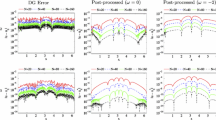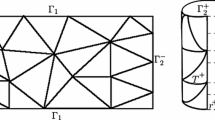Abstract
In this paper, we develop and analyze discontinuous Galerkin (DG) methods to solve hyperbolic equations involving \(\delta \)-singularities. Negative-order norm error estimates for the accuracy of DG approximations to \(\delta \)-singularities are investigated. We first consider linear hyperbolic conservation laws in one space dimension with singular initial data. We prove that, by using piecewise \(k\)th degree polynomials, at time \(t\), the error in the \(H^{-(k+2)}\) norm over the whole domain is \((k+1/2)\)th order, and the error in the \(H^{-(k+1)}(\mathbb R \backslash \mathcal R _t)\) norm is \((2k+1)\)th order, where \(\mathcal R _t\) is the pollution region due to the initial singularity with the width of order \(\mathcal O (h^{1/2} \log (1/h))\) and \(h\) is the maximum cell length. As an application of the negative-order norm error estimates, we convolve the numerical solution with a suitable kernel which is a linear combination of B-splines, to obtain \(L^2\) error estimate of \((2k+1)\)th order for the post-processed solution. Moreover, we also obtain high order superconvergence error estimates for linear hyperbolic conservation laws with singular source terms by applying Duhamel’s principle. Numerical examples including an acoustic equation and the nonlinear rendez-vous algorithms are given to demonstrate the good performance of DG methods for solving hyperbolic equations involving \(\delta \)-singularities.






Similar content being viewed by others
References
Bramble, J.H., Schatz, A.H.: High order local accuracy by averaging in the finite element method. Math. Comput. 31, 94–111 (1977)
Canuto, C., Fagnani, F., Tilli, P.: An Eulerian approach to the analysis of Rendez-vous algorithms. In: Chung, M.J., Misra, P. (eds.) 17th IFAC World Congress 2008, vol. 17, Part 1. Curran, Red Hook, New York (2009)
Chalaby, A.: On convergence of numerical schemes for hyperbolic conservation laws with stiff source terms. Math. Comput. 66, 527–545 (1997)
Ciarlet, P.G.: Finite Element Method For Elliptic Problems. North-Holland, Amsterdam (1978)
Cockburn, B.: A Introduction to the discontinuous Galerkin methods for convection dominated problems. In: Barth, T., Deconink, H. (eds.) High-Order Method for Computational Physics. Lecture Notes in Computational Science and Engineering, vol. 9, pp. 69–224. Springer, Berlin (1999)
Cockburn, B., Guzmán, J.: Error estimate for the Runge-Kutta discontinuous Galerkin method for the transport equation with discontinuous initial data. SIAM J. Numer. Anal. 46, 1364–1398 (2008)
Cockburn, B., Hou, S., Shu, C.W.: The Runge-Kutta local projection discontinuous Galerkin finite element method for conservation laws IV: the multidimensional case. Math. Comput. 54, 545–581 (1990)
Cockburn, B., Lin, S.Y., Shu, C.W.: TVB Runge-Kutta local projection discontinuous Galerkin finite element method for conservation laws III: one-dimensional systems. J. Comput. Phys. 84, 90–113 (1989)
Cockburn, B., Luskin, M., Shu, C.W., Süli, E.: Enhanced accuracy by post-processing for finite element methods for hyperbolic equations. Math. Comput. 72, 577–606 (2003)
Cockburn, B., Shu, C.W.: TVB Runge-Kutta local projection discontinuous Galerkin finite element method for conservation laws II: general framework. Math. Comput. 52, 411–435 (1989)
Cockburn, B., Shu, C.W.: The Runge-Kutta discontinuous Galerkin method for conservation laws V: multidimensional systems. J. Comput. Phys. 141, 199–224 (1998)
Greenberg, J.M., Leroux, A.Y., Baraille, R., Noussair, A.: Analysis and approximation of conservation laws with source terms. SIAM J. Numer. Anal. 34, 1980–2007 (1997)
Gottlieb, S., Shu, C.W., Tadmor, E.: Strong stability-preserving high-order time discretization methods. SIAM Rev. 43, 89–112 (2001)
Hou, S., Liu, X.D.: Solutions of multi-dimensional hyperbolic systems of conservation laws by square entropy condition satisfying discontinuous Galerkin method. J. Sci. Comput. 31, 127–151 (2007)
Jiang, G.S., Shu, C.W.: On a cell entropy inequality for discontinuous Galerkin methods. Math. Comput. 62, 531–538 (1994)
John, F.: Partial different equations. Springer, New York (1971)
Johnson, C., Nävert, U., Pitkäranta, J.: Finite element methods for linear hyperbolic problems. Comput. Methods Appl. Mech. Eng. 45, 285–312 (1984)
Johnson, C., Pitkäranta, J.: An analysis of the discontinuous Galerkin method for a scalar hyperbolic equation. Math. Comput. 46, 1–26 (1986)
Johnson, C., Schatz, A., Walhbin, L.: Crosswind smear and pointwise errors in streamline diffusion finite element methods. Math. Comput. 49, 25–38 (1987)
Koren, B.: A robust upwind discretization method for advection, diffusion and source terms. Notes on Numerical Fluid Mechanics, vol. 45, pp. 117–138. Vieweg, Braunschweig (1993)
LeVeque, R.J., Yee, H.C.: A study of numerical methods for hyperbolic conservation laws with stiff source terms. J. Comput. Phys. 86, 187–210 (1990)
Noussair, A.: Analysis of nonlinear resonance in conservation laws with point sources and well-balanced scheme. Stud. Appl. Math. 104, 313–352 (2000)
de Oliveira, P., Santos, J.: On a class of high resolution methods for solving hyperbolic conservation laws with source terms. In: Sequeira, A., da Veiga, H.B., Videman, J.H. (eds.) Applied Nonlinear Analysis, pp. 432–445. Kluwer academic publishers, New York (1999)
Reed, W.H., Hill, T.R.: Triangular mesh methods for the Neutron transport equation. Los Alamos Scientific Laboratory Report LA-UR-73-479, Los Alamos, NM (1973)
Ryan, J.K., Cockburn, B.: Local derivative post-processing for the discontinuous Galerkin method. J. Comput. Phys. 228, 8642–8664 (2009)
Ryan, J.K., Shu, C.W.: On a one-sided post-processing technique for the discontinuous Galerkin methods. Methods Appl. Anal. 10, 295–308 (2003)
Santos, J., de Oliveira, P.: A converging finite volume scheme for hyperbolic conservation laws with source terms. J. Comput. Appl. Math. 111, 239–251 (1999)
Schroll, H.J., Winther, R.: Finite-difference Schemes for scalar conservation laws with source terms. IMA J. Numer. Anal. 16, 201–215 (1996)
Slingerland, P.V., Ryan, J.K., Vuik, C.: Position-dependent smooth-increasing accuracy-conserving (SIAC) filtering for improving discontinuous Galerkin solutions. SIAM J. Sci. Comput. 33, 802–825 (2011)
Walfisch, D., Ryan, J.K., Kirby, R.M., Haimes, R.: One-sided smoothness-increasing accuracy-conserving filtering for enhanced streamline integration through discontinuous fields. J. Sci. Comput. 38, 164–184 (2009)
Zhang, Q., Shu, C.W.: Error estimates for the third order explicit Runge-Kutta discontinuous Galerkin method for linear hyperbolic equation in one-dimension with discontinuous initial data. Numerische Mathematik. (2013, submitted)
Zhang, X., Shu, C.W.: On positivity preserving high order discontinuous Galerkin schemes for compressible Euler equations on rectangular meshes. J. Comput. Phys. 229, 8918–8934 (2010)
Author information
Authors and Affiliations
Corresponding author
Additional information
This research was supported by DOE grant DE-FG02-08ER25863 and NSF grant DMS-1112700.
Appendix A: Proof of Lemma 3.1
Appendix A: Proof of Lemma 3.1
In this appendix we prove Lemma 3.1. The main line of proof is based on the idea in [6, 31]. For simplicity, we only consider \(\delta \)-singularity in equation (1.2), hence \(u_0(x)=\delta (x)+f(x)\), where \(f(x)\) is sufficiently smooth and has a compact support on the computational domain \(\Omega \).
1.1 A.1 The weight function
Let \(\varphi (x)\) be a positive bounded function, which can be taken as a weight function. For any function \(q\in H^1_h,\) we define the weighted \(L^2\)-norm as
in the domain \(D.\) If \(\varphi =1\) or \(D=\Omega ,\) the corresponding subscript will be omitted.
In this paper, we will consider two weight functions \(\varphi ^1(x,t)\) and \(\varphi ^{-1}(x,t)\), respectively, in order to determine the left-hand and right-hand boundary of the region \(\mathcal R _T\) such that, outside this region, we can resume the \((k+1)\)th order accuracy in the \(L^2\)-norm. Both weight functions are related to the cut-off of the exponent function \(\phi (r)\in C^1:\Omega \rightarrow \mathbb R \),
and they are defined as the solutions of the linear hyperbolic problem,
where \(\gamma >0,\,0<\sigma <1\) and \(x_c\) are three parameters which will be chosen later. We always assume \(\gamma h^{\sigma -1}\ge 1\) in this section.
In [31], the authors have listed several properties about the two weight functions. Here, we state some of them that will be used.
Proposition 7.1
For each of the weight function \(\varphi ^a(x,t)\), the following properties hold
Lemma 7.1
Let \(\mathbb V \) be a Gauss–Radau projection, either \(\mathbb P _-\) or \(\mathbb P _+\). For any sufficiently smooth function \(p(x)\), there exists a positive constant \(C\) independent of \(h\) and \(p\), such that
where \(D\) is either the single cell \(I_j\) or the whole computational domain \(\Omega \).
Lemma 7.2
For any function \(v\in V_h\) there holds the following identity
1.2 A.2 The smooth solution
We consider the following problem
where the initial condition \(v_0(x)\), is a sufficiently smooth function modified from the original initial condition \(u_0(x)=\delta (x)+f(x)\) such that it agrees with \(u_0(x)\) for all \(x\in \Omega \backslash I_i\), and satisfies
where \(I_i\) is the cell containing \(x=0\).
1.3 A.3 Error representation and error equations
Denote the error by \(e=v-u_h\), where \(u_h\) approximates to equation (1.2) or equation(7.9). Clearly, \(e\) also satisfies the scheme (2.2) with \(g(x,t)=0\). We divide the error into the form \(e=\eta -\xi \), where
Then following [31], we obtain
where
First we estimate \(\Pi _1\). Denote \(w=\xi _t-\mathbb P _{k-1}\xi _t.\) From the scheme (2.3), we have
Plugging the above into \(\Pi _1\) and defining \(\psi =\sqrt{\varphi },\) we obtain
Summing up with respect to \(j\), we obtain
For \(\Pi _2\), it is not difficult to find out that
Then if \(\gamma \) is large enough and \(\sigma =\frac{1}{2}\), we have
By Gronwall’s inequality,
1.4 A.4 The final estimate
This part is almost the same as in [31]. We will only discuss the left-hand boundary of \(\mathcal R _T\) since the discussion for the right one is similar. Denote \(x_L(t)=t+x_c\) with
where \(s\) and \(\gamma \) are sufficiently large and \(\sigma =1/2\). As we have mentioned before, the \(\delta \)-singularity in the initial datum is contained in the cell \(I_i\). Then by proposition A.1, we obtain \(0<\phi (x)<h^s\) for any \(x\in I_i\). We choose \(v_0\) to satisfy \(\mathbb P _kv_0=\mathbb P _ku_0=u_h(0)\), then
If \(s\) is large enough, then \(\Vert \xi (0)\Vert _\varphi \le Ch^{k+1}.\)
Define the domain \(\mathcal R _T^+=(x_L(T),\infty )\), then
To estimate the second term on the right hand side, we need to use (7.11). Denote
and \(\mathcal R _1(t)=(-\infty ,w(t)),\,\mathcal R _2(t)=\mathbb R \backslash \mathcal R _1(t)=(w(t),\infty )\). If \(\gamma h^{\sigma -1}\) is large enough, \(\mathcal R _1(t)\) stays away from the bad interval \([t-h,t+h]\) where \(v(x,t)\ne u(x,t),\) then we have
Now we proceed to estimate \(\Vert \eta _t\Vert _{\varphi ,\mathcal R _2(t)}\). Since \(\mathcal R _2\) contains the whole bad region, we will use the property of the weight function. By (7.4) we have \(\varphi \le h^s\) in this zone. Then we obtain
Similarly, we can estimate the right-hand side of the non-smooth region. If we take s large enough, we have
Rights and permissions
About this article
Cite this article
Yang, Y., Shu, CW. Discontinuous Galerkin method for hyperbolic equations involving \(\delta \)-singularities: negative-order norm error estimates and applications. Numer. Math. 124, 753–781 (2013). https://doi.org/10.1007/s00211-013-0526-8
Received:
Revised:
Published:
Issue Date:
DOI: https://doi.org/10.1007/s00211-013-0526-8




